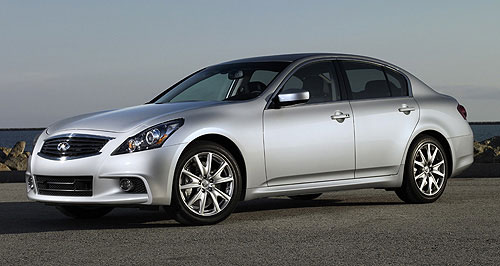News - General News - SalesAADA fears flood of used importsFor example: The Infiniti G37/Nissan Skyline is a common used import. Don’t relax laws on used vehicle imports, says AADA24 Feb 2014 By IAN PORTER THE Productivity Commission has been urged to withdraw its recommendation that all restrictions on the importation of used vehicles be lifted. Lifting restrictions would create a deluge of used vehicles with doubtful histories, unreliable integrity and suspect ownership, according to the Australian Automotive Dealer Association. Across the Tasman in New Zealand, used imports brought into the country through non-factory channels are comparatively common-place. It would also require the establishment of a bureaucracy to ensure that all cars imported met required safety, environmental and ownership standards. However, the well-established business of importing pre-1970 muscle cars like Mustangs and Camaros would not be affected, GoAuto has been told. The recommendation to de-restrict used vehicle imports was one of several contained in the commission’s Position Paper on the Australian car manufacturing industry released on January 31, but was comparatively overlooked. “We have grave concerns about what consumer benefit there would be, particularly in the bona fides of the cars brought in,” said AADA chief executive Patrick Tessier. As part of its recommendation, the PC said the $12,000 specific duty on imported used cars appeared to be “largely redundant”. The commission also appeared to indicate that the federal government should set up a system to manage the used car imports. “However, appropriate regulatory measures are required to ensure that consumer protection, community safety and environmental performance standards are maintained before the restrictions are removed,” the two commissioners, Mike Woods and Philip Weickhardt, said in the paper. “These concerns are best dealt with directly, through regulatory standards applicable to all vehicles sold in Australia,” they added. Given that the imports will be handled by independent operators and will not be backed by the manufacturers, this suggests that the cars will have to be inspected for compliance when they are unloaded in Australia. Mr Tessier agreed, saying that the de-restriction of used vehicle imports would require “very strict guidelines” in order to reassure buyers as to the bona fides of the cars. He is also concerned that the imported used vehicles may not meet Australian Design Rules (ADRs). For instance, it is compulsory for cars sold in Australia to be fitted with electronic stability control. “Are we intending to abandon ADRs, because that’s what we would be doing? Or are we still going to enforce the ADR requirements?” Mr Tessier was also concerned about the integrity of the imported cars. “How does a consumer know they are getting one car and not two cars?” he asked, referring to the “re-birthing” of crashed or stolen cars. “There are risks attached to it,” he said. “My view is a simple one. We have 64 brands represented in Australia. Cars are cheaper now than they have ever been in my lifetime. “We have more choice than we can deal with and we have more new models coming by the hour. “We have a car park of 20 million cars and there are only 23 million of us. We’re adding another line of cars if we start importing more used cars.” Mr Tessier said consumers would have to be on the alert. He believes that most of the cars imported would come from Japan and would likely only be three years old. The Japanese government supports the Japanese car industry by requiring stringent roadworthy checks, particularly after three years. This means there are many three-year-old cars on the used market. Mr Tessier said that, while these cars might look the same as cars sold in Australia, they could have different safety or environmental specifications, specifications that don’t meet the ADRs. And, while a car sold in Australia might have a five-year warranty, a used import of the same age would have none, he said. “The risk to the consumer is great because they can’t interrogate the previous owner of the car about its condition or whether it had damage. “I don’t believe there is any productivity to be gained by it.” The good news for car enthusiasts is the importing of pre-1989 muscle cars will be unaffected if the government does take up the PC’s recommendation. But that does not mean that all is well when it comes to bringing Mustangs, Camaros and Dodge Chargers into the country, said leading muscle car importer Tony Giannakis. “There’s used cars and there’s classic cars. They shouldn’t be bringing normal cars in. No-one should be,” Mr Giannakis told GoAuto. His company, TGS Muscle Cars, is a licensed motor vehicle trader and brings in around 35-40 American muscle cars a year under the pre-1989 provisions of the importing regulations. “(The PC recommendations) wouldn’t really affect me. We only do old cars. “But even that should be tightened up so that no-one should be allowed to bring old cars in who isn’t a dealer. Because that’s been happening.” And it has been costing Canberra a lot in GST not paid. “At least if there is an LMCT dealer, they have responsibilities for the car to be safe, and someone can come back at them and they can lose their LMCT licence. “So many of these cars, 50 per cent or more I would say, are coming in privately. They are just bringing them in to make a quick profit. They don’t pay GST because they claim to be private. “Since I have been in the car industry, it has never been policed. “It’s supposed to be only three cars a year they sell, but they use their mothers’ name, brothers, cousins, it just keeps going on.”  Read more |
Click to shareGeneral News articlesResearch General News Motor industry news |















Facebook Twitter Instagram